博弈论试题3答案
网课博弈论考试题及答案

网课博弈论考试题及答案一、单项选择题(每题2分,共20分)1. 博弈论中,两个参与者的博弈被称为()。
A. 零和博弈B. 非零和博弈C. 多人博弈D. 双人博弈答案:D2. 在博弈论中,参与者在决策时不考虑其他参与者的决策,这种博弈被称为()。
A. 合作博弈B. 非合作博弈C. 完全信息博弈D. 不完全信息博弈答案:B3. 博弈论中的“纳什均衡”是由哪位数学家提出的?()A. 冯·诺依曼B. 约翰·纳什C. 约翰·冯·诺依曼D. 约翰·纳什·冯·诺依曼答案:B4. 在博弈论中,如果一个参与者的最优策略不依赖于其他参与者的策略选择,这种博弈被称为()。
A. 独立博弈B. 完全信息博弈C. 不完全信息博弈D. 零和博弈答案:A5. 在博弈论中,如果一个参与者的收益增加,另一个参与者的收益也会增加,这种博弈被称为()。
A. 零和博弈B. 非零和博弈C. 合作博弈D. 竞争博弈答案:B6. 博弈论中的“囚徒困境”是一个经典的()。
A. 零和博弈B. 非零和博弈C. 合作博弈D. 完全信息博弈答案:B7. 在博弈论中,如果参与者的收益矩阵是对称的,这种博弈被称为()。
A. 对称博弈B. 不对称博弈C. 完全信息博弈D. 不完全信息博弈答案:A8. 在博弈论中,如果参与者在决策时不知道其他参与者的收益矩阵,这种博弈被称为()。
A. 完全信息博弈B. 不完全信息博弈C. 零和博弈D. 非零和博弈答案:B9. 在博弈论中,如果参与者在决策时能够观察到其他参与者的行动,这种博弈被称为()。
A. 完全信息博弈B. 不完全信息博弈C. 静态博弈D. 动态博弈答案:A10. 在博弈论中,如果参与者在决策时不能观察到其他参与者的行动,这种博弈被称为()。
A. 完全信息博弈B. 不完全信息博弈C. 静态博弈D. 动态博弈答案:B二、多项选择题(每题3分,共15分)11. 博弈论中,以下哪些是博弈的类型?()A. 零和博弈B. 非零和博弈C. 合作博弈D. 非合作博弈答案:ABCD12. 在博弈论中,以下哪些是博弈的分类方式?()A. 完全信息博弈B. 不完全信息博弈C. 静态博弈D. 动态博弈答案:ABCD13. 博弈论中,以下哪些是博弈的策略形式?()A. 纯策略B. 混合策略C. 纳什均衡D. 支配策略答案:ABD14. 在博弈论中,以下哪些是博弈的结果?()A. 纳什均衡B. 帕累托最优C. 核心D. 优势策略均衡答案:ABCD15. 博弈论中,以下哪些是博弈的参与者?()A. 玩家B. 参与者C. 策略D. 收益答案:AB三、判断题(每题2分,共10分)16. 博弈论中的“纳什均衡”是指在给定其他参与者的策略下,没有任何一个参与者能够通过改变自己的策略来获得更好的收益。
博弈论期末考试试题及答案
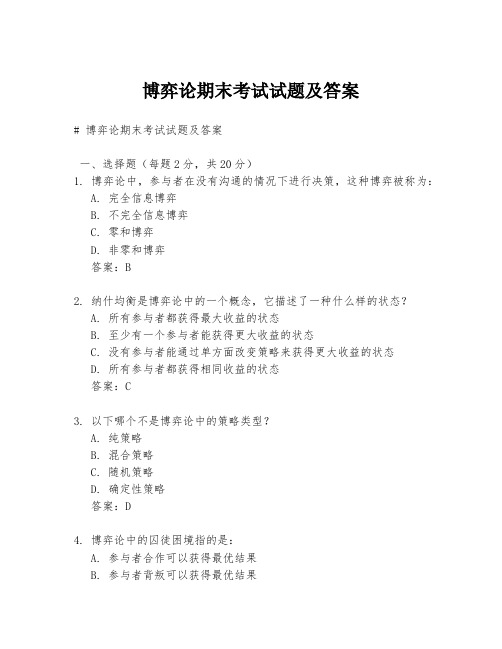
博弈论期末考试试题及答案# 博弈论期末考试试题及答案一、选择题(每题2分,共20分)1. 博弈论中,参与者在没有沟通的情况下进行决策,这种博弈被称为:A. 完全信息博弈B. 不完全信息博弈C. 零和博弈D. 非零和博弈答案:B2. 纳什均衡是博弈论中的一个概念,它描述了一种什么样的状态?A. 所有参与者都获得最大收益的状态B. 至少有一个参与者能获得更大收益的状态C. 没有参与者能通过单方面改变策略来获得更大收益的状态D. 所有参与者都获得相同收益的状态答案:C3. 以下哪个不是博弈论中的策略类型?A. 纯策略B. 混合策略C. 随机策略D. 确定性策略答案:D4. 博弈论中的囚徒困境指的是:A. 参与者合作可以获得最优结果B. 参与者背叛可以获得最优结果C. 参与者合作可以获得次优结果,但背叛可以获得最优结果D. 参与者背叛可以获得次优结果,但合作可以获得最优结果答案:C5. 以下哪个不是博弈论中的基本概念?A. 参与者B. 策略C. 收益D. 概率答案:D...二、简答题(每题10分,共30分)1. 解释什么是博弈论,并给出一个实际生活中的例子。
答案:博弈论是研究具有冲突和合作特征的决策者之间互动的数学理论。
在实际生活中,博弈论的一个例子是拍卖。
在拍卖中,买家(参与者)需要决定出价(策略)以赢得商品(收益),同时考虑其他买家的出价策略。
2. 描述纳什均衡的概念,并解释为什么它在博弈论中如此重要。
答案:纳什均衡是指在非合作博弈中,每个参与者选择自己的最优策略,并且考虑到其他参与者的策略选择时,没有参与者能通过单方面改变策略来获得更大的收益。
纳什均衡在博弈论中非常重要,因为它提供了一种预测参与者行为的方法,即在均衡状态下,参与者没有动机去改变他们的策略。
3. 什么是完全信息博弈和不完全信息博弈?它们之间有什么区别?答案:完全信息博弈是指所有参与者都完全知道博弈的结构和其他参与者的收益函数。
而不完全信息博弈是指至少有一个参与者对博弈的结构或其它参与者的收益函数不完全了解。
大学博弈论试题及答案

大学博弈论试题及答案一、选择题(每题2分,共20分)1. 在博弈论中,非合作博弈是指:A. 参与者之间可以达成协议B. 参与者之间不能达成协议C. 参与者之间必须达成协议D. 参与者之间只能通过合作达到目标答案:B2. 纳什均衡是博弈论中的一个概念,它描述了一种情况,即:A. 所有参与者都处于最优策略B. 至少有一个参与者处于非最优策略C. 所有参与者都处于非最优策略D. 至少有一个参与者可以单方面改变策略以获得更好的结果答案:A3. 囚徒困境中,如果两个参与者都选择合作,那么:A. 他们都将获得最大收益B. 他们都将获得最小收益C. 他们都将获得中等收益D. 他们中的一个将获得最大收益,另一个获得最小收益答案:C4. 零和博弈是指:A. 一个参与者的收益等于另一个参与者的损失B. 参与者的总收益为零C. 参与者的总损失为零D. 参与者的总收益和总损失相等答案:B5. 在博弈论中,策略是指:A. 参与者的行动计划B. 参与者的收益C. 参与者的损失D. 参与者的支付结构答案:A6. 博弈论中的“混合策略”是指:A. 参与者随机选择策略B. 参与者总是选择相同的策略C. 参与者的策略是固定的D. 参与者的策略是预先确定的答案:A7. 博弈论中的“支配策略”是指:A. 无论对手选择什么策略,都是最优的策略B. 只有在特定情况下才是最优的策略C. 只有在对手选择特定策略时才是最优的策略D. 参与者总是选择的策略答案:A8. 博弈论中的“重复博弈”是指:A. 博弈只进行一次B. 博弈进行多次,但每次都是独立的C. 博弈进行多次,且参与者的记忆会影响后续决策D. 博弈进行多次,但参与者不能记住之前的决策答案:C9. 在博弈论中,如果一个策略在任何情况下都不是最优的,那么这个策略被称为:A. 支配策略B. 支配策略的反面C. 支配策略的替代D. 非支配策略答案:B10. 博弈论中的“共同知识”是指:A. 所有参与者都知道的信息B. 只有部分参与者知道的信息C. 参与者之间的秘密D. 参与者之间共享的信念答案:A二、填空题(每题2分,共20分)1. 在博弈论中,如果一个策略在任何情况下都不是最优的,那么这个策略被称为________。
博弈数学测试题及答案
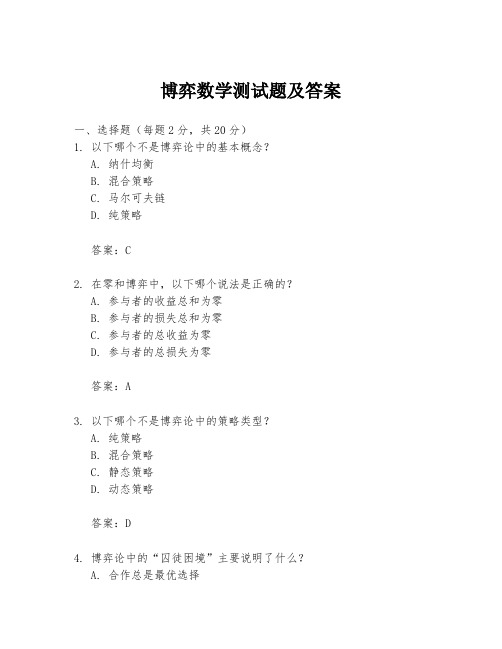
博弈数学测试题及答案一、选择题(每题2分,共20分)1. 以下哪个不是博弈论中的基本概念?A. 纳什均衡B. 混合策略C. 马尔可夫链D. 纯策略答案:C2. 在零和博弈中,以下哪个说法是正确的?A. 参与者的收益总和为零B. 参与者的损失总和为零C. 参与者的总收益为零D. 参与者的总损失为零答案:A3. 以下哪个不是博弈论中的策略类型?A. 纯策略B. 混合策略C. 静态策略D. 动态策略答案:D4. 博弈论中的“囚徒困境”主要说明了什么?A. 合作总是最优选择B. 个体理性可能导致集体非理性C. 集体理性总是最优选择D. 个体非理性可能导致集体理性答案:B5. 在博弈论中,以下哪个不是纳什均衡的特点?A. 每个参与者都选择了自己的最优策略B. 每个参与者的策略都是对其他参与者策略的最佳响应C. 参与者可以通过改变策略来获得更好的结果D. 所有参与者都达到了自己可能的最大收益答案:C6. 以下哪个是博弈论中的合作博弈?A. 囚徒困境B. 石头剪刀布C. 公共品博弈D. 零和博弈答案:C7. 在博弈论中,哪个术语描述了参与者在没有沟通的情况下做出决策?A. 沟通博弈B. 非合作博弈C. 同时博弈D. 顺序博弈答案:C8. 以下哪个不是博弈论中的结果类型?A. 帕累托效率B. 纳什均衡C. 社会福利最大化D. 个人最优答案:D9. 在博弈论中,以下哪个不是博弈的分类?A. 完全信息博弈B. 不完全信息博弈C. 静态博弈D. 动态博弈答案:C10. 以下哪个是博弈论中的“重复博弈”?A. 参与者只进行一次决策B. 参与者进行多次决策C. 参与者在博弈中没有记忆D. 参与者在博弈中不能交流答案:B二、填空题(每空1分,共10分)1. 博弈论是由数学家______提出的。
答案:约翰·冯·诺伊曼2. 博弈论中的“纳什均衡”是由______命名的。
答案:约翰·纳什3. 在博弈论中,如果参与者的策略选择是相互独立的,这种博弈被称为______博弈。
生活中的博弈论试题和答案

1.假设三个人要在纸上写下金额,而且不可以说出来。
他们必须在1元到100元之间挑一个整数(包括1和100),所编写数字最小的人则可以得到他所编写的金额。
如果有平手的情形,总奖金则由赢的人平分。
所以如果A写53元,B写22元,C写30元,则B可以得到22元;如果A写53元,B写22元,C也写22元,则B 和C就会各自得到11元,因为他们要平分这22元。
在所有人都很理性的情况下,找出这个博弈的合理结果,并给出分析过程。
(10分)答:(1)假设前提是所有人都很理性,那么,对于所有人,每人写100元都能得到最多的钱,但是这样每个人只能分到100元的三分之一,那么此时如果是A,在第一次博弈中为了得到最多的钱,便会写99元。
(2)当A想写99元时,B、C同样作这样的决策,那么此时三个人就只能每人获得33元,进而,又会重复之前的博弈。
(3)直到最后三个人都写了1元,因为三个人都非常的理性,而三个人之间又不够信任,就只能陷入困境,最终每个人只能会得到1块钱的三分之一。
2.你在9个信封里各装了100元,第10个信封里则没有装东西。
你把这些信封混在一起,小张随便挑了一个信封打开来看。
小李提议让他出一笔钱买下小张所挑选的信封,但他在提出这项建议时,并不知道小张的信封里有没有钱。
小张可以接受小李的出价,也可以拒绝并把信封留下来。
小李应该出多少钱买小张的信封?请说明理由。
(10分)答:(1)如果小张小李都是理性人,那么根据概率方法,小李最多会出90元买信封,所以,小李的出钱范围是1-90元。
(2)而小张知道信封里到底有没有一百块钱,如果信封里有100,那么小李出任意小于100的数,小张都不会同意,在依据小李的出钱范围,小李会出1元。
(3)如果信封里没有100,那么小李出任意小于100的数,小张都会同意,在依据小李的出钱范围,小李出1元才是合理的。
(4)综合而言,无论里面有没有100元,小李都应该出1块钱买信封,如果小张同意,则小李便以1块钱买了一个信封。
“博弈论”习题及参考答案

《博弈论》习题一、单项选择题1.博弈论中,局中人从一个博弈中得到的结果常被称为()。
A. 效用B. 支付C. 决策D. 利润2.博弈中通常包括下面的内容,除了()。
A.局中人B.占优战略均衡C.策略D.支付3.在具有占优战略均衡的囚徒困境博弈中()。
A.只有一个囚徒会坦白B.两个囚徒都没有坦白C.两个囚徒都会坦白D.任何坦白都被法庭否决了4.在多次重复的双头博弈中,每一个博弈者努力()。
A.使行业的总利润达到最大B.使另一个博弈者的利润最小C.使其市场份额最大D.使其利润最大5.一个博弈中,直接决定局中人支付的因素是()。
A. 策略组合B. 策略C. 信息D. 行动6.对博弈中的每一个博弈者而言,无论对手作何选择,其总是拥有惟一最佳行为,此时的博弈具有()。
A.囚徒困境式的均衡B.一报还一报的均衡C.占优策略均衡D.激发战略均衡7.如果另一个博弈者在前一期合作,博弈者就在现期合作;但如果另一个博弈者在前一期违约,博弈者在现期也违约的策略称为()。
A.一报还一报的策略B.激发策略C.双头策略D.主导企业策略8.在囚徒困境的博弈中,合作策略会导致()。
A.博弈双方都获胜B.博弈双方都失败C.使得先采取行动者获胜D.使得后采取行动者获胜9.在什么时候,囚徒困境式博弈均衡最可能实现()。
A. 当一个垄断竞争行业是由一个主导企业控制时B.当一个寡头行业面对的是重复博弈时C.当一个垄断行业被迫重复地与一个寡头行业博弈时D. 当一个寡头行业进行一次博弈时10.一个企业采取的行为与另一个企业在前一阶段采取的行为一致,这种策略是一种()。
A.主导策略B.激发策略C.一报还一报策略D.主导策略11.关于策略式博弈,正确的说法是()。
A. 策略式博弈无法刻划动态博弈B. 策略式博弈无法表明行动顺序C. 策略式博弈更容易求解D. 策略式博弈就是一个支付矩阵12.下列关于策略的叙述哪个是错误的():A. 策略是局中人选择的一套行动计划;B. 参与博弈的每一个局中人都有若干个策略;C. 一个局中人在原博弈中的策略和在子博弈中的策略是相同的;D. 策略与行动是两个不同的概念,策略是行动的规则,而不是行动本身。
博弈论试题及答案
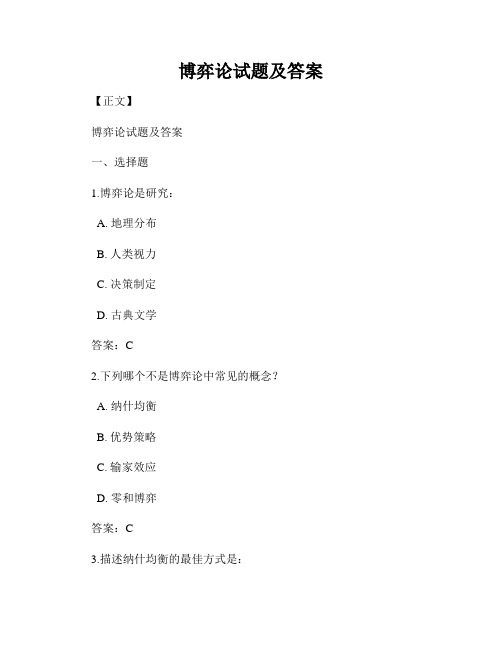
博弈论试题及答案【正文】博弈论试题及答案一、选择题1.博弈论是研究:A. 地理分布B. 人类视力C. 决策制定D. 古典文学答案:C2.下列哪个不是博弈论中常见的概念?A. 纳什均衡B. 优势策略C. 输家效应D. 零和博弈答案:C3.描述纳什均衡的最佳方式是:A. 所有参与者都达到最佳策略B. 至少有一个参与者达到最佳策略C. 所有参与者都达到次优策略D. 至少有一个参与者达到次优策略答案:A4.下列哪个案例体现了零和博弈的情况?A. 两国签订贸易协定B. 赌徒在赌博中争夺赌注C. 两家公司合作推出新产品D. 好友一起玩棋盘游戏答案:B5.下列哪个不是博弈论的应用之一?A. 经济决策B. 政治博弈C. 生物进化D. 音乐创作答案:D二、填空题1.博弈论最早由_____________等人于20世纪40年代提出。
答案:冯·诺依曼(John von Neumann)2.博弈论是研究参与者间的_____________和_____________的学科。
答案:互动行为;决策制定3.零和博弈是指参与者的利益总和恒为_____________。
答案:零4.博弈论中的最佳策略指的是在其他参与者采取某个策略时,使某一参与者的_____________最大化的策略。
答案:利益5.斯坦福大学的_____________教授以其对博弈论的突出贡献而获得2005年诺贝尔经济学奖。
答案:约翰·纳什(John Nash)三、简答题1.简要解释博弈论中的纳什均衡。
答:纳什均衡是博弈论中的一个重要概念,指的是在参与者选择自己最佳策略的情况下,不存在任何一个参与者可以通过单独改变自己的策略来获得更好收益的状态。
简言之,纳什均衡是一种理性选择下的稳定状态。
2.举例说明博弈论在实际生活中的应用。
答:博弈论在经济学、政治学、生物学等领域中都有广泛应用。
例如,在贸易谈判中,两个国家之间的博弈就是典型的博弈论应用。
博弈论习题

博弈论习题一、判断1、纳什均衡即任一博弈方单独改变策略都只能得到更小利益的策略组合。
错,只要任一博弈方单独改变策略不会增加得益,策略组合就是纳什均衡了。
本题说的是严格纳什均衡。
2、若一博弈有两个纯战略纳什均衡则一定还存在一个混合战略纳什均衡。
对的,NE的基本性质之一——奇数性所保证的。
3、博弈中混合策略纳什均衡一定存在,纯战略的不一定存在。
对4、上策均衡一定是帕累托最优的均衡。
错,囚徒困境,(坦白,坦白)是上策均衡但不是帕累托最优。
5、在动态博弈中,因为后行为的博弈方可以先观察到对方行为后再做选择,因此总是有利的。
错,先动优势6、动态博弈本身也是自己的子博弈之一。
错,根据子博弈的定义,整个博弈本身不是自己的子博弈。
7、如果动态博弈的一个策略组合不仅在均衡路径上是纳什均衡,而且在非均衡路径上也是纳什均衡,就是该动态博弈的一个子博弈完美纳什均衡。
对,8逆推归纳法并不能排除所有不可置信的威胁、错,逆推归纳法最基本的特征就是能排除动态博弈中所有不可信行为,包括不可信威胁和不可信承诺。
9、颤抖手均衡与第二章的风险上策均衡都是在有风险和不确定情况下的稳定策略组合,因为她们本质上是一样的。
错,区别很大。
前者是针对很小的犯错误导致的偏离概率的均衡概念,对博弈方的理性假设与完全理性假设基本接近,且本身是纳什均衡。
10、有限次重复博弈的子博弈完美纳什均衡每次重复均采用的都是原博弈的纳什均衡。
错,对于有两个以上纯策略纳什均衡博弈的有限次重复博弈,SPNE在前面某些次重复时采用的可以不是原博弈的NE,例如许多出发策略。
11、有限次重复博弈的子博弈完美纳什均衡的最后一次重复必定是原博弈的一个纳什均衡。
对,因为最后一次重复就是动态博弈对的最后一个阶段,根据SPNE的要求,博弈方在该阶段的选择必须构成纳什均衡。
最后一次博弈就是原博弈本身12、无限次重复博弈的均衡解一定优于原博弈均衡解的得益。
错,对于严格竞争的零和博弈或者不满足合作条件的其他博弈来说,无限次重复博弈并不意味着效率的提高,得益不一定高。
第十章 博弈论 试题

D.精炼贝叶斯均衡中的最优概念是指战略最优。
E.精练贝叶斯的是由海萨尼定义的。
4、在动态博弈战略行动中():
A.首先作出选择并采取相应行动的局中人往往可以获得更多的收益;
B.斯塔克博格模型与古诺模型对两个垄断厂商行为的分析方法及得出的结论相同;
D. 在采用重复剔除的方法博弈游戏中,一定存在占优均衡。
13、右图为某一博弈的得益矩阵,据此可知():
A. 甲与乙均没有上策; B. 甲与乙均有上策;
C. 甲有上策而乙没有上策;D. 甲没有上策而乙有上策。
14、对于右上图表示的博弈,其上策均衡或纳什均衡由哪一个格子代表的策略组合来表示()
A. 左上角; B. 右上角; C. 左下角; D. 右下角。
5、简述博弈的构成要素及其特征。
六、计算
1、博弈的收益矩阵如下表:
乙
左
右
甲
上
a,b
c,d
下
e,f
g,h
(1)如果(上,右)是占优策略均衡,则a、b、c、d、e、f、g、h之间必然满足哪些关系?(尽量把所有必要的关系式都写出来)
(2)如果(上,右)是纳什均衡,则(1)中的关系式哪些必须满足?
(3)如果(上,右)是占优策略均衡,那么它是否一定是纳什均衡?
B企业
大
小
A企业
大
3,3
-1,-1
小
-1,-1
2,2
(1)假设企业A先走一步,企业B的策略选择有多少种?写出A和B的策略组合及相应的收益矩阵。
(2)在这些策略组合中,有无纳什均衡?如有,哪些是?
(3)将上述策略组合写成树型博弈形式,并求出子博弈完美纳什均衡。
博弈论考试题及答案
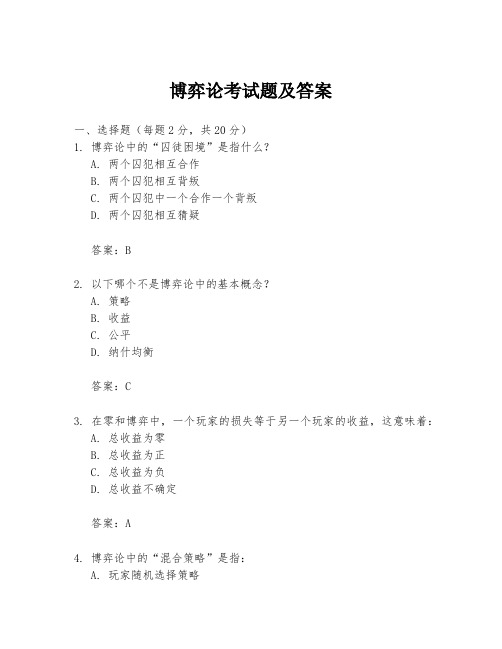
博弈论考试题及答案一、选择题(每题2分,共20分)1. 博弈论中的“囚徒困境”是指什么?A. 两个囚犯相互合作B. 两个囚犯相互背叛C. 两个囚犯中一个合作一个背叛D. 两个囚犯相互猜疑答案:B2. 以下哪个不是博弈论中的基本概念?A. 策略B. 收益C. 公平D. 纳什均衡答案:C3. 在零和博弈中,一个玩家的损失等于另一个玩家的收益,这意味着:A. 总收益为零B. 总收益为正C. 总收益为负D. 总收益不确定答案:A4. 博弈论中的“混合策略”是指:A. 玩家随机选择策略B. 玩家固定选择一种策略C. 玩家根据对手的策略选择策略D. 玩家不使用策略答案:A5. 以下哪个是博弈论中的“完全信息”博弈?A. 拍卖博弈B. 石头剪刀布C. 桥牌D. 信息不对称博弈答案:C6. 博弈论中的“重复博弈”指的是:A. 博弈只进行一次B. 博弈进行多次C. 博弈进行无限次D. 博弈进行有限次但次数未知答案:B7. 以下哪个是博弈论中的“动态博弈”?A. 零和博弈B. 非零和博弈C. 同时博弈D. 顺序博弈答案:D8. 在博弈论中,如果一个策略组合是纳什均衡,那么:A. 每个玩家都有动机单方面改变策略B. 每个玩家都满足于当前策略C. 至少有一个玩家不满意当前策略D. 所有玩家都不满意当前策略答案:B9. 博弈论中的“合作博弈”是指:A. 玩家之间可以形成联盟B. 玩家之间不能形成联盟C. 玩家之间只能通过竞争来获得收益D. 玩家之间只能通过合作来获得收益答案:A10. 以下哪个是博弈论中的“公共知识”?A. 每个玩家的收益函数B. 每个玩家的策略选择C. 每个玩家的偏好D. 每个玩家的个人信息答案:A二、简答题(每题10分,共30分)1. 简述博弈论中的“纳什均衡”概念。
答案:纳什均衡是指在一个博弈中,每个玩家都选择了自己的最优策略,并且没有玩家能够通过单方面改变策略来提高自己的收益。
在纳什均衡状态下,每个玩家的策略是对其他玩家策略的最优反应。
经济博弈论试题及答案
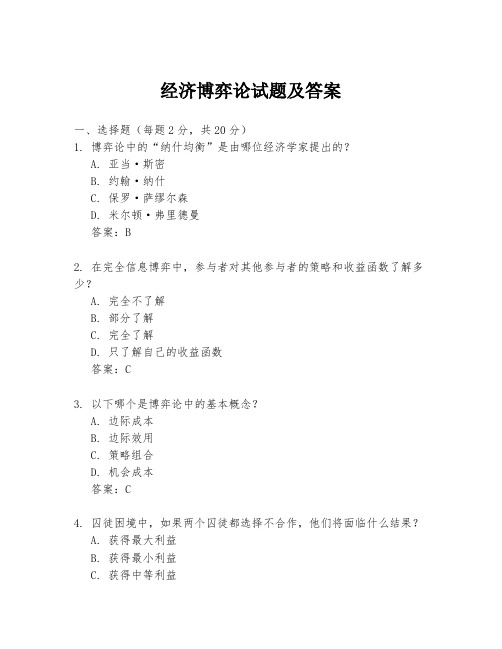
经济博弈论试题及答案一、选择题(每题2分,共20分)1. 博弈论中的“纳什均衡”是由哪位经济学家提出的?A. 亚当·斯密B. 约翰·纳什C. 保罗·萨缪尔森D. 米尔顿·弗里德曼答案:B2. 在完全信息博弈中,参与者对其他参与者的策略和收益函数了解多少?A. 完全不了解B. 部分了解C. 完全了解D. 只了解自己的收益函数答案:C3. 以下哪个是博弈论中的基本概念?A. 边际成本B. 边际效用C. 策略组合D. 机会成本答案:C4. 囚徒困境中,如果两个囚徒都选择不合作,他们将面临什么结果?A. 获得最大利益B. 获得最小利益C. 获得中等利益D. 无法预测答案:B5. 以下哪个不是博弈论中的策略类型?A. 纯策略B. 混合策略C. 随机策略D. 固定策略答案:D二、简答题(每题10分,共30分)6. 简述博弈论在经济学中的应用。
答案:博弈论在经济学中的应用广泛,包括但不限于市场结构分析、拍卖理论、竞争策略、合作与联盟形成、公共品提供、以及政策制定等。
博弈论帮助经济学家理解个体在不同情境下的决策行为,预测市场动态,为政策制定提供理论依据。
7. 解释什么是“零和博弈”。
答案:零和博弈是一种特殊类型的博弈,其中参与者的总收益为零。
这意味着一个参与者的收益增加必然伴随着另一个参与者的损失,整个博弈的总收益是不变的。
这种博弈通常涉及到竞争关系,而非合作。
8. 描述“重复博弈”的特点。
答案:重复博弈是指同样的博弈结构在一定时间间隔内重复进行多次。
其特点包括参与者可以学习对手的行为模式,策略可能随时间调整,以及长期合作的可能性增加。
重复博弈中的策略选择往往更加复杂,因为参与者需要考虑未来博弈的影响。
三、计算题(每题25分,共50分)9. 假设有两个公司A和B,它们可以选择高成本生产(H)或低成本生产(L)。
如果两个公司都选择H,它们各自获得利润为100万元;如果都选择L,各自获得利润为50万元;如果一个选择H而另一个选择L,选择L的公司获得150万元利润,而选择H的公司则亏损50万元。
博弈论考试试题及答案

博弈论考试一试题以及答案所以,希望您起码在某些题目上有优秀的表现。
2、要求您独立达成全部题目,您的答案(主要指论述题)与其余同学若有显然相同,纯属互相剽窃,绝非偶合。
3、本试卷题目的难度必定足以充足展现您的才能,希望您能够尽可能达成全部的题目,以便最大限度地显示您的水平,无愧于您作为天之宠儿的盛誉。
4、希望您和任课老师博弈的均衡结局是:您全力以赴并优秀地达成了全部的题目,迫使老师不得不给您一个高分。
6、请把你学号的尾数除以 3,把余数填在封面相应的地点。
1、第一题( 20 分):要求第一用文字论述你所经历的案例,然后用抽象成博弈论模型并进行剖析。
(3)学号尾数除以 3 余 2 的同学剖析:举一个你所经历的斗鸡博弈的实例,在实质博弈中你采纳什么行动让你是成为“猛士”的;答: 1996 年长虹公司与海尔公司价钱战。
在实质的博弈中,我或许虚张阵容给他人以心理上的打击进而击溃他人的心理防线,迫使敌手做出退步。
进而成为猛士 .2、第二题( 20 分):请举例说明以下说法能否正确,结构博弈模型详细说明,论述原由。
( 3)学号尾数除以 3 余 2 的同学判断剖析“知道的越多越好”答:达尔文的生物进化论说明,人生活在世界上实质上就是和他人竞争。
物竞天择适者生计。
在竞争强烈的社会中,时机只看重有准备的人,知道得越多,此后遇到问题解决问题的能力也就越强,时机也就越多,利润也越大。
在以下结构的博弈论模型中能够反应出来。
乙多少甲多5,510,0少0,100,0对于甲而言,知道的少利润为零,所以甲选择知道多,对于乙也相同。
依据占优策略均衡,甲乙将同时选择知道得多进而( 5,5)达到纳什均衡。
所以对于甲乙而言,知道得多的,将利润越大,“知道得越多越好” 。
3、第三题( 20 分):( 3)学号尾数除以 3 余 2 的同学做:以下是皇帝与元勋博弈的战略表达式,剖析三种不一样状况的均衡结果,联合有关历史事实对此中的差别进行议论。
博弈论复习题及答案

博弈论复习题及答案1. 博弈论中,非合作博弈与合作博弈的主要区别是什么?答案:非合作博弈是指参与者之间没有约束性协议的博弈,每个参与者都独立地选择自己的策略以最大化自己的利益。
而合作博弈则允许参与者之间形成具有约束力的协议,共同合作以达到共同的目标。
2. 什么是纳什均衡?答案:纳什均衡是指在一个博弈中,每个参与者都选择了最优策略,并且考虑到其他参与者的策略后,没有参与者有动机单方面改变自己的策略。
3. 零和博弈与非零和博弈有何不同?答案:零和博弈是指博弈中所有参与者的收益总和为零,即一个参与者的收益必然导致另一个参与者的损失。
非零和博弈则是指参与者的收益总和不为零,参与者之间可能存在合作共赢的情况。
4. 如何判断一个博弈是否存在纯策略纳什均衡?答案:可以通过构建博弈的收益矩阵,然后寻找每个参与者在其他参与者策略给定的情况下的最佳响应策略。
如果存在一组策略,使得每个参与者在其他参与者策略不变的情况下,都没有动机改变自己的策略,那么这个策略组合就是一个纯策略纳什均衡。
5. 混合策略纳什均衡与纯策略纳什均衡有何不同?答案:纯策略纳什均衡是指参与者在均衡状态下选择的策略是确定的,而混合策略纳什均衡则是指参与者在均衡状态下选择的策略是随机的,每个策略都有一定的概率被选择。
6. 什么是支配策略?答案:支配策略是指在博弈中,无论其他参与者选择什么策略,某个参与者选择该策略都能获得比其他策略更好的结果。
7. 博弈论中的“囚徒困境”说明了什么?答案:“囚徒困境”说明了即使合作对所有参与者都有利,但由于缺乏信任和沟通,参与者可能会选择对自身最有利的策略,导致集体结果不是最优的。
8. 什么是博弈论中的“倒后归纳法”?答案:“倒后归纳法”是一种解决动态博弈的方法,通过从博弈的最后阶段开始,逆向分析每个阶段的最优策略,直到博弈的初始阶段。
9. 博弈论在经济学中的应用有哪些?答案:博弈论在经济学中的应用非常广泛,包括但不限于市场结构分析、拍卖理论、合同理论、产业组织、宏观经济政策分析等。
博弈论考研试题及答案

博弈论考研试题及答案试题:博弈论考研模拟试题一、单项选择题(每题2分,共10分)1. 在博弈论中,非合作博弈与合作博弈的主要区别在于()。
A. 参与者的数量B. 参与者是否可以形成具有约束力的协议C. 博弈的支付结构D. 博弈的时间顺序2. 囚徒困境中,如果两个参与者都选择背叛对方,那么他们将()。
A. 获得最大的个人利益B. 获得最大的集体利益C. 获得最小的个人利益D. 获得最小的集体利益3. 纳什均衡的概念是由哪位数学家提出的?()A. 约翰·纳什B. 约翰·冯·诺伊曼C. 让·梯若尔D. 莱昂尼德·赫维茨4. 在完全信息博弈中,每个参与者都完全知道博弈的结构和其他所有参与者的()。
A. 收益B. 策略C. 收益和策略D. 偏好5. 动态博弈与静态博弈的主要区别在于()。
A. 参与者的互动次数B. 是否存在随机因素C. 参与者的知识水平D. 博弈的支付方式二、简答题(每题10分,共20分)1. 简述零和博弈和非零和博弈的区别,并各举一例。
2. 解释什么是“弱支配策略”和“强支配策略”,并给出一个包含这两种策略的博弈例子。
三、计算题(每题15分,共30分)1. 考虑一个两人博弈,参与者A和B分别有两个策略:高风险(H)和低风险(L)。
支付矩阵如下:| B\ | H | LA \H | 3,2 | 4,1L | 2,3 | 1,4计算并找出这个博弈的纳什均衡。
2. 假设一个市场上有两个公司,公司1和公司2,它们可以选择高广告投入(H)或低广告投入(L)。
支付矩阵如下:| 2\ | H | L1 \H | 100,100 | 80,120L | 120,80 | 60,60计算并找出这个博弈的纳什均衡,并讨论如果公司能够形成合作协议,他们可能如何改变策略。
四、论述题(每题20分,共20分)1. 论述博弈论在经济学中的应用,并举例说明。
答案:一、单项选择题1. B2. C3. A4. C5. A二、简答题1. 零和博弈是指在一个博弈中,一个参与者的收益恰好等于另一个参与者的损失,总和为零。
经济博弈论试题及答案

经济博弈论试题及答案(正文部分)第一部分:试题1. 请简要解释什么是经济博弈论。
2. 请列举并解释博弈论中的一些重要概念,如纳什均衡、占优策略和囚徒困境等。
3. 在实际生活中,经济博弈论有哪些应用领域?请举例说明。
4. 什么是合作博弈?请阐述合作博弈的特点,并提供一个相关的实例。
5. 请简述零和博弈与非零和博弈的区别,并给出一个具体案例。
第二部分:答案1. 经济博弈论是一种集合数学、经济学和策略分析于一体的理论框架,用于研究决策者在相互关联的环境中做出决策时所面临的策略选择和结果影响。
2. (1) 纳什均衡:指在博弈中,所有参与者都选择最优策略时所构成的一组策略组合,使得没有一个参与者单方面改变策略可以使自己的收益提高。
(2) 占优策略:指在博弈中,一方参与者在某种策略下收益最大化,无论其他参与者采用何种策略。
(3) 囚徒困境:是博弈论中的一个经典案例,描述的是两个囚犯是否应该合作以最大化自己的收益。
在该案例中,即使合作能带来最优结果,囚犯之间因互相不信任而往往选择背叛。
3. 经济博弈论在实际生活中有广泛的应用。
例如:(1) 在企业竞争中,博弈论可以帮助企业决定定价策略和市场竞争策略,以及对手可能采取的行动。
(2) 在国际贸易谈判中,博弈论可以用于分析各个国家的利益诉求和谈判策略,以实现最优结果。
(3) 在环境保护领域,博弈论可以用于研究各个利益相关方之间的博弈行为,以促进合作与共识。
4. 合作博弈是指参与者在博弈中通过合作来实现收益最大化的行为。
合作博弈的特点包括:(1) 合作和沟通:参与者可以进行合作,共同制定策略,并通过沟通交流来实现最优结果。
(2) 利益共享:参与者之间共享合作所带来的利益,以实现总体收益的最大化。
(3) 长期合作:合作博弈通常需要参与者在长期内保持合作,以实现稳定的收益。
例子:两个企业在同一个市场上竞争,它们可以选择合作并共同制定定价策略,以实现最大化利润。
通过长期合作和有序竞争,两个企业可以避免价格战和利润损失。
《博弈论》期末考试试题

《博弈论》期末考试试题2003年12月,适用于:工商管理2000限选、全校2001任选1、鹰-鸽(Hawk-Dove)博弈(30分)两动物为某一食物而争斗。
每只动物都能象鸽或鹰那样行动。
对每只动物来说最坏的结果是两个都象鹰一样,此时的争斗使得双方都吃不到食物;如果两只动物合作起来象鸽一样行动,则每只动物都可吃到3个单位的食物;如果自己象鸽而对手象鹰,则自己只能吃到1个单位而对手可吃到4个单位。
假设两只动物进行的是一次性完全信息静态博弈,请回答如下问题:(1)请作出此博弈的支付矩阵,并明确描述出博弈的参与人和他的行动空间。
(2)请求解此博弈的全部纳什均衡(纯策略或混合策略纳什均衡)。
(3)请举一个现实生活中的例子并用鹰-鸽博弈进行解释。
2、狩猎博弈(20分)卢梭在他的《论人类不平等的起源和基础》中说到:如果一群猎人出发去猎一头鹿,他们完全意识到,为了成功,他们必须都要忠实地坚守自己的位置;然而如果一只野兔碰巧经过他们中的一个人附近,毫无疑问他会毫不迟疑地追逐它,一旦他获得了自己的猎物,他就不太关心他的同伴是否错失了他们的目标。
现在对上述描述简化。
假设只有两个猎人,他们必须同时决定是猎鹿还是野兔。
如果两个人均决定猎鹿,那么他们会获得一头鹿(价值1000元),并在他们之中进行平分;如果两个人均猎野兔,那么他们每个人可以获得一只野兔(价值100元);如果一个猎兔而另一个猎鹿,则前者获得一只野兔,后者将一无所获。
如果每个人都希望自己得到尽可能多的猎物,请作出支付矩阵并分析此博弈的纯策略纳什均衡。
3、设一四阶段两博弈方之间的动态博弈如下图所示,请回答下列问题。
(30分)(1)试找出全部子博弈;(2)讨论该博弈中的可信性问题;(3)求解子博弈精练纳什均衡和博弈的结果。
4、试运用所学知识解释下列现象(20分):根据经济学的基本原理,一般商品都是价格越低购买者越多,但为什么在现实生活中会出现低价不好销售、提高价格后反而更好销售的现象呢?你认为什么样的商品容易出现这种反常现象?。
博弈论经济学考试题及答案

博弈论经济学考试题及答案博弈论是经济学中的一个重要分支,它研究具有冲突和合作特征的决策者之间的互动。
以下是一套博弈论经济学的考试题及答案,供参考。
一、选择题(每题2分,共20分)1. 以下哪项不是博弈论的基本概念?A. 纳什均衡B. 完全信息C. 零和游戏D. 边际效用答案:D2. 囚徒困境中,如果两个囚犯都选择不合作,他们将各自获得什么结果?A. 最大利益B. 最小损失C. 纳什均衡D. 合作结果答案:C3. 以下哪个不是博弈论中的策略类型?A. 纯策略B. 混合策略C. 随机策略D. 确定性策略答案:D4. 博弈论中的“支配策略”指的是什么?A. 总是最优的策略B. 总是最差的策略C. 只在某些情况下最优的策略D. 只在对手采取特定策略时最优的策略答案:A5. 重复博弈中,以下哪个概念不是用于描述博弈的长期行为?A. 信誉B. 惩罚C. 一次性博弈D. 合作答案:C二、简答题(每题10分,共30分)1. 请简述什么是纳什均衡,并给出一个例子。
答案:纳什均衡是博弈论中的一个概念,指的是在一个非合作博弈中,每个参与者选择了自己的策略,并且没有一个人可以通过改变自己的策略而单方面获得更好的结果。
例如,在囚徒困境中,如果两个囚犯都选择沉默,那么他们各自获得的结果比互相揭发要好,即使他们知道如果都揭发对方,结果会更糟。
这种情况下,沉默就是他们的纳什均衡。
2. 解释“完全信息”和“不完全信息”博弈的区别。
答案:完全信息博弈是指所有参与者都完全知道博弈的结构和所有其他参与者的收益函数。
而不完全信息博弈是指至少有一个参与者对博弈的结构或至少一个其他参与者的收益函数不完全了解。
例如,在拍卖中,如果所有竞拍者都知道拍卖品的真实价值,这就是完全信息博弈;如果竞拍者对拍卖品的价值只有部分信息,这就是不完全信息博弈。
3. 什么是混合策略均衡?请举例说明。
答案:混合策略均衡是指在博弈中,参与者以一定的概率选择不同的策略,使得没有参与者可以通过改变自己的策略选择而获得更好的结果。
博弈论案例分析[试题]
![博弈论案例分析[试题]](https://img.taocdn.com/s3/m/f7983ad188eb172ded630b1c59eef8c75fbf9598.png)
博弈论案例分析博弈论分析一、经济学中的“智猪博弈”(Pigs’payoffs)这个例子讲的是:猪圈里有两头猪,一头大猪,一头小猪。
猪圈的一边有个踏板,每踩一下踏板,在远离踏板的猪圈的另一边的投食口就会落下少量的食物。
如果有一只猪去踩踏板,另一只猪就有机会抢先吃到另一边落下的食物。
当小猪踩动踏板时,大猪会在小猪跑到食槽之前刚好吃光所有的食物;若是大猪踩动了踏板,则还有机会在小猪吃完落下的食物之前跑到食槽,争吃到另一半残羹。
那么,两只猪各会采取什么策略?答案是:小猪将选择“搭便车”策略,也就是舒舒服服地等在食槽边;而大猪则为一点残羹不知疲倦地奔忙于踏板和食槽之间。
原因何在?因为,小猪踩踏板将一无所获,不踩踏板反而能吃上食物。
对小猪而言,无论大猪是否踩动踏板,不踩踏板总是好的选择。
反观大猪,已明知小猪是不会去踩动踏板的,自己亲自去踩踏板总比不踩强吧,所以只好亲力亲为了。
“小猪躺着大猪跑”的现象是由于故事中的游戏规则所导致的。
规则的核心指标是:每次落下的事物数量和踏板与投食口之间的距离。
如果改变一下核心指标,猪圈里还会出现同样的“小猪躺着大猪跑”的景象吗?试试看。
改变方案一:减量方案。
投食仅原来的一半分量。
结果是小猪大猪都不去踩踏板了。
小猪去踩,大猪将会把食物吃完;大猪去踩,小猪将也会把食物吃完。
谁去踩踏板,就意味着为对方贡献食物,所以谁也不会有踩踏板的动力了。
如果目的是想让猪们去多踩踏板,这个游戏规则的设计显然是失败的。
改变方案二:增量方案。
投食为原来的一倍分量。
结果是小猪、大猪都会去踩踏板。
谁想吃,谁就会去踩踏板。
反正对方不会一次把食物吃完。
小猪和大猪相当于生活在物质相对丰富的“共产主义”社会,所以竞争意识却不会很强。
对于游戏规则的设计者来说,这个规则的成本相当高(每次提供双份的食物);而且因为竞争不强烈,想让猪们去多踩踏板的效果并不好。
改变方案三:减量加移位方案。
投食仅原来的一半分量,但同时将投食口移到踏板附近。
博弈论期末试题及答案

博弈论期末试题及答案一、选择题(每题2分,共40分)1. 博弈论的核心概念是:A. 均衡分析B. 策略分析C. 利润分析D. 收益分析2. Nash均衡是指:A. 所有玩家达到最优结果B. 没有玩家可以通过改变策略获得更好结果C. 所有玩家都选择相同的策略D. 所有玩家都选择不同的策略3. 在零和博弈中,一方的收益是另一方的:A. 收益的相反数B. 收益的平方C. 收益的负数D. 收益的倒数4. 最优响应策略是指:A. 在对手的策略给定时,玩家自己的最优策略B. 在对手的策略给定时,对手的最优策略C. 利用数学模型计算得到的最优策略D. 随机选择的策略5. 以下哪个是非合作博弈的扩展形式:A. 矩阵形式B. 博弈树形式C. 序列形式D. 重复博弈形式6. 当两位玩家在重复博弈中都选择合作策略时,他们的总收益是:A. 最大化的B. 最小化的C. 平均化的D. 不确定7. 最优子博弈在博弈树中的作用是:A. 寻找博弈的子集B. 确定博弈过程的时间C. 减少博弈的复杂性D. 避免剪枝8. 以下哪个是非合作博弈的解决概念:A. 纳什均衡B. 支配策略C. 策略剖析D. 相对策略9. 在纳什均衡中,每个玩家都是:A. 个体理性的B. 无知的C. 合作的D. 随机的10. 在博弈论中,支配策略指的是:A. 无论对手选择什么策略,都能带来最好结果的策略B. 无论自己选择什么策略,都能带来最好结果的策略C. 无论对手选择什么策略,都会带来最坏结果的策略D. 无论自己选择什么策略,都会带来最坏结果的策略二、简答题(每题10分,共20分)1. 请解释什么是零和博弈,并举例说明。
零和博弈是一种博弈模型,其中一个玩家的收益等于另一个玩家的损失,总收益为零,也就是说一方的利益必然导致另一方的损失。
举例来说,两个商家在一个市场上销售相同的商品,他们之间的竞争就可以看作是零和博弈。
一方的销售额的增加必然导致另一方的销售额减少。
- 1、下载文档前请自行甄别文档内容的完整性,平台不提供额外的编辑、内容补充、找答案等附加服务。
- 2、"仅部分预览"的文档,不可在线预览部分如存在完整性等问题,可反馈申请退款(可完整预览的文档不适用该条件!)。
- 3、如文档侵犯您的权益,请联系客服反馈,我们会尽快为您处理(人工客服工作时间:9:00-18:30)。
SPE 315 Game Theory Problem Set 3 Solutions
Professor Derek Liu
1.a) The normal form of the game is:
The game is zero-sum.
b) The extensive form version of the simultaneous move game is:
(the green dashed line indicates the information set)
c) The unique NE is in mixed strategy, i.e. the mutual best response is to
randomize the strategy choices. Prisoner plays Climb Wall with probability .5 and Dig Tunnel with probability .5; Warden plays Guards at Wall with probability .5 and Regular inspections with probability .5.
d) The extensive form version of the sequential move game where the
warden is the first mover is
The backward induction solution is that if Warden chooses to guard the
wall, Prisoner chooses Dig Tunnel and if Warden chooses regular
inspections, Prisoner chooses Climb Wall. The solution will be different, as the Prisoner can perfectly condition on the Warden’s behavior and so the Prisoner can always win the game.
2.This game is a Prisoner’s Dilemma.
a) Here is one possible parameterization of the game:
b) Both players have a dominant strategy: offer rewards card.
c) In equilibrium, Rita’s cool card will also offer 1 free ice cream for
every 10 purchased. If it offered a better deal, Bruster’s would have to
match it and if it offered a worse deal, it would lose business to Bruster’s.
3.Marienbad
a) Obvious: player 1 takes a match from 1 of the two piles. Since the last
player to pick up a match loses the game, and each player must pick up a number of matches from one of the two piles, player 2 will lose.
b) If m=n>1, let us write the initial configuration of matches in the two
piles as (m,m). Suppose after player 1’s first move the configuration is
(k,m), where k is a number between 0 and m-1 (players must remove a least one stick from one pile). If k=0, player 2 can then remove m-1 matches from the second pile, so that when it is player 1’s move, the configuration of the two piles is (0,1); in this case player 2 wins the game. If k>0, then player 2 moves the game to (k, k) (mimics the choice of player 1 and equalizes the two piles).
Now it is player 1’s turn again; suppose he moves the game to (j,k). If j=0, player 2 removes k-1 matches from the second pile and wins the game.
If j>0 player 2 moves the game to (j,j). In this fashion, after no more than m-1 moves by player 1, the game must arrive at a configuration such as
(1,p), where p>1 and it is player 2’s move. Player 2 then removes the p
sticks from the second pile and wins the game. (Note: for simplicity I
assumed that player 1 always removes from the first pile, but this
assumption is not crucial since every time player 1 makes a move --unless he has eliminated all the sticks from one of the piles--the two piles have
equal numbers of sticks due to the strategy of player 2).
c) Player 1 can equalize the two piles in his first move. If he then
follows the strategy pursued by player 2 in part b, he will win the game. 4.a)
b) A risk neutral investor treats expected payoffs the same as certain
payoffs. The expected payoff from opening the restaurant is .35 x 300,000 + .65 x 0 = $105,000. Since this is larger than the payoff from not opening the restaurant, $100,000, the risk neutral investor opens the restaurant. A
risk-averse investor might not necessarily follow the same decision. A
risk-averse investor prefers a certain payoff to an uncertain payoff, which has the same expected payoff as the certain payoff.
c)
The answer to part b is unchanged because the investor does not know
nature’s first move. The lack of information about the move made by nature is indicated by the dashed line (representing a single information set). The game is a simultaneous move game, since the investor does not know
nature’s choice and nature does not know the investor’s choice.。
